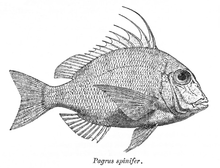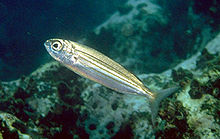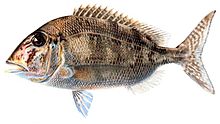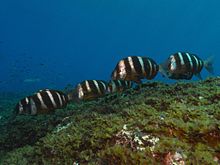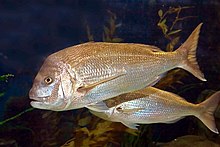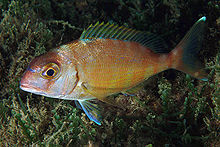Sea bream
| Sea bream | ||||||||||||
|---|---|---|---|---|---|---|---|---|---|---|---|---|

Two-banded bream ( Diplodus vulgaris ) |
||||||||||||
| Systematics | ||||||||||||
|
||||||||||||
| Scientific name | ||||||||||||
| Sparidae | ||||||||||||
| Rafinesque , 1810 |
The sea bream (Sparidae) are a family of perch relatives (Percomorphaceae), which consists of almost 40 genera with more than 140 species . They are 12 centimeter to 2 meter long fish that live in schools in the tropical and subtropical open ocean around the world. Half of all known species live in South African waters. In the Mediterranean 24 species. A few species also come into brackish and fresh water.
features
Sea bream are high-backed animals, with a laterally compressed body and an often silvery basic color, dark transverse bands and a black tail spot. There are also bluish, reddish or yellowish colors. The dorsal fin is continuous and is usually supported by 10 to 13 spines and 10 to 15 soft rays. The front rays can be elongated in the form of threads, e.g. B. at Argyrops and Dentex . The anal fin has three spines and 8 to 14 soft rays. The pectoral fins are long and pointed, the caudal fin is forked or at least notched. The number of vertebrae is 24 (10 trunk and 14 caudal vertebrae), and that of the Branchiostegal rays is six. Your maxillaria are covered when the mouth is closed. The gill cover is not bristled, the eye gill is large. The jaw teeth are designed as incisors, fangs or molars in adaptation to the diet. The ploughshare and palatine bone are edentulous. The sideline is complete, the body covered by comb scales, which in some species can still be almost cycloid .
Way of life
Among them there are omnivores, pure herbivores, as well as carnivorous species that usually eat hard-shell prey such as mussels, snails and crabs. The different species have specialized teeth according to their diet.
Sea bream are often hermaphrodites . Either they have female and male sexual organs at the same time, or in the course of their life they are first male and then female (protandric), or first female and then male (protogyn).
They are excellent food fish.
External system
The sea bream, together with the big-headed snappers (Lethrinidae) and the pseudo- snappers ( Nemipteridae), form a group of related "sparoid" families, which some scientists regarded as a superfamily (Sparoidea) of the Percoidei , but later as a separate order (Spariformes) from the perch-like ( Perciformes) was spun off. The Lethrinidae are the sister group of the sea bream.
Internal system
The sea bream used to be divided into six subfamilies (Boopsinae, Denticinae, Diplodinae, Pagellinae, Pagrinae and Sparinae). However, the subfamilies were recognized in phylogenetic studies as not monophyletic . Instead, two previously unnamed main clades were found.
There are over 160 species (not all listed here) in almost 40 genera:
- Genus Acanthopagrus
- Acanthopagrus akazakii Iwatsuki, 2013
- Acanthopagrus arabicus (Iwatsuki, Kimura & Yoshino, 2006)
- Acanthopagrus australis ( Gunther , 1859)
- Common bream ( Acanthopagrus berda ) ( Forsskål , 1775)
- Two-band bream ( Acanthopagrus bifasciatus ) (Forsskål, 1775)
- Acanthopagrus butcheri (Munro, 1949)
- Yellowfin sea bream ( Acanthopagrus latus ) ( Houttuyn , 1782)
- Acanthopagrus morrisoni Iwatsuki, 2013
- Acanthopagrus palmaris ( Whitley , 1935)
- Acanthopagrus schlegelii ( Bleeker , 1854)
- Acanthopagrus sheim Iwatsuki, 2013
- Acanthopagrus sivicolus (Akazaki, 1962)
- Acanthopagrus taiwanensis (Iwatsuki & Carpenter, 2006)
- Genus Amamiichthys Tanaka & Iwatsuki, 2015
- Amamiichthys matsubarai (Akazaki, 1962)
- Genus Archosargus
- Archosargus pourtalesii ( Steindachner , 1881)
- Archosargus probatocephalus ( Walbaum , 1792)
- Archosargus rhomboidalis ( Linnaeus , 1758)
- Genus Argyrops
- Argyrops bleekeri (Oshima, 1927)
- Argyrops caeruleops Iwatsuki & Heemstra, 2018
- Argyrops filamentosus ( Valenciennes , 1830)
- Argyrops flavops Iwatsuki & Heemstra, 2018
- Argyrops megalommatus (Klunzinger, 1870)
- Argyrops notialis Iwatsuki & Heemstra, 2018
- Argyrops spinifer (Forsskål, 1775)
- Genus Argyrozona
- Argyrozona argyrozona (Valenciennes, 1830)
- Genus Boops
- Bogue bream ( Boops boops ) (Linnaeus, 1758)
- Boops lineatus ( Boulenger , 1892)
- Genus Boopsoidea
- Boopsoidea inornata ( Castelnau , 1861)
- Genus Calamus
- Calamus arctifrons (Goode & Bean, 1882)
- Dickkopf bream ( Calamus bajonado ) (Bloch & Schneider, 1801)
- Calamus brachysomus (Lockington, 1880)
- Bigeye bream ( Calamus calamus ) (Valenciennes, 1830)
- Calamus campechanus (Randall & Caldwell, 1966)
- Calamus cervigoni (Randall & Caldwell, 1966)
- Calamus leucosteus (Jordan & Gilbert, 1885)
- Calamus mu (Randall & Caldwell, 1966)
- Calamus nodosus (Randall & Caldwell, 1966)
- Calamus penna (Valenciennes, 1830)
- Calamus pennatula (Guichenot, 1868)
- Calamus proridens (Jordan & Gilbert, 1884)
- Calamus taurinus (Jenyns, 1840)
- Genus Centracanthus
- Centracanthus cirrus Rafinesque , 1810
- Genus Cheimerius
- Cheimerius nufar (Valenciennes, 1830)
- Genus Chrysoblephus
- English bream ( Chrysoblephus anglicus ) (Gilchrist & Thompson, 1908)
- Chrysoblephus cristiceps (Valenciennes, 1830)
- Chrysoblephus gibbiceps (Valenciennes, 1830)
- Chrysoblephus laticeps (Valenciennes, 1830)
- Chrysoblephus lophus (Fowler, 1925)
- Chrysoblephus puniceus (Gilchrist & Thompson, 1908)
- Genus Crenidens
- Crenidens crenidens (Forsskål, 1775)
- Genus Cymatoceps
- Shellcracker ( Cymatoceps nasutus ) (Castelnau, 1861)
- Genus Dentex
- Dentex angolensis (Poll & Maul, 1953)
- Dentex barnardi (Cadenat, 1970)
- Dentex canariensis (Steindachner, 1881)
- Dentex carpenteri Iwatsuki et al., 2015
- Dentex congoensis (Poll, 1954)
- Bream ( Dentex dentex ) (Linnaeus, 1758)
- Dentex fourmanoiri (Akazaki & Séret, 1999)
- Dentex gibbosus (Rafinesque, 1810)
- Dentex macrophthalmus (Bloch, 1791)
- Morocco sea bream ( Dentex maroccanus ) (Valenciennes, 1830)
- Dentex multidens (Valenciennes, 1830)
- Dentex spariformis Ogilby , 1910
- Dentex tumifrons (Temminck & Schlegel, 1843)
- Genus Diplodus
- Ringed bream ( Diplodus annularis ) (Linnaeus, 1758)
- Diplodus argenteus (Valenciennes, 1830)
- Diplodus bellottii (Steindachner, 1882)
- Diplodus bermudensis (Caldwell, 1965)
- Diplodus capensis (Smith, 1844)
- Five-banded bream ( Diplodus cervinus ) (Lowe, 1838)
- Diplodus fasciatus (Valenciennes, 1830)
- Diplodus holbrookii (Bean, 1878)
- Diplodus levantinus Fricke et al., 2016
- Red sea bream ( Diplodus noct ) (Valenciennes, 1830)
- Diplodus prayensis (Cadenat, 1964)
- Pointed Bream ( Diplodus puntazzo ) (Cetti, 1777)
- Goat bream ( Diplodus sargus ) (Linnaeus, 1758)
- Two-banded bream ( Diplodus vulgaris ) (Geoffroy Saint-Hilaire, 1817)
- Genus Evynnis
- Evynnis cardinalis (Lacepède, 1802)
- Evynnis japonica (Tanaka, 1931)
- Genus Gymnocrotaphus
- Gymnocrotaphus curvidens (Günther, 1859)
- Genus Lagodon
- Lagodon rhomboides (Linnaeus, 1766)
- Genus Lithognathus
- Lithognathus aureti (Smith, 1962)
- Lithognathus lithognathus (Cuvier, 1829)
- Marble bream ( Lithognathus mormyrus ) (Linnaeus, 1758)
- Lithognathus olivieri (Penrith & Penrith, 1969)
- Genus Oblada
- Brandebream ( Oblada melanura ) (Linnaeus, 1758)
- Genus Pachymetopon
- Pachymetopon aeneum (Gilchrist & Thompson, 1908)
- Pachymetopon blochii (Valenciennes, 1830)
- Pachymetopon grande (Günther, 1859)
- Genus Pagellus
- Axillary bream ( Pagellus acarne ) (Risso, 1827)
- Pagellus affinis (Boulenger, 1888)
- Pagellus bellottii (Steindachner, 1882)
- Red bream ( Pagellus bogaraveo ) (Brünnich, 1768)
- Red bream ( Pagellus erythrinus ) (Linnaeus, 1758)
- Pagellus natalensis (Steindachner, 1903)
- Genus Pagrus
- Pagrus africanus (Akazaki, 1962)
- Pagrus auratus (Forster, 1801)
- European sea bream ( Pagrus auriga ) (Valenciennes, 1843)
- Pagrus caeruleostictus (Valenciennes, 1830)
- Pagrus major (Temminck & Schlegel, 1843)
- Common sea bream ( Pagrus pagrus ) (Linnaeus, 1758)
- Genus Parargyrops
- Parargyrops edita (Tanaka, 1916)
- Genus Peter
- Petrus rupestris (Valenciennes, 1830)
- Genus Polyamblyodon
- Polyamblyodon germanum (Barnard, 1934)
- Polyamblyodon gibbosum (Pellegrin, 1914)
- Genus Polysteganus
- Polysteganus baissaci Smith, 1978
- Polysteganus cerasinus Iwatsuki & Heemstra, 2015
- Polysteganus coeruleopunctatus (Klunzinger, 1870)
- Polysteganus flavodorsalis Iwatsuki & Heemstra, 2015
- Polysteganus lineopunctatus (Boulenger, 1903)
- Polysteganus mascarenensis Iwatsuki & Heemstra, 2011
- Polysteganus praeorbitalis (Günther, 1859)
- Polysteganus undulosus (Regan, 1908)
- Genus Porcostoma
- South African dentate ( Porcostoma dentata ) (Gilchrist & Thompson, 1908)
- Genus Pterogymnus
- Pterogymnus laniarius (Valenciennes, 1830)
- Genus Rhabdosargus
- Rhabdosargus globiceps (Valenciennes, 1830)
- Rhabdosargus haffara (Forsskål, 1775)
- Rhabdosargus holubi (Steindachner, 1881)
- Rhabdosargus niger Tanaka & Iwatsuki, 2013
- Rhabdosargus sarba (Forsskål, 1775)
- Rhabdosargus thorpei (Smith, 1979)
- Genus Sarpa
- Goldstriemenbrasse ( Sarpa salpa ) (Linnaeus, 1758)
- Genus Sparidentex
- Sparidentex hasta (Valenciennes, 1830)
- Sparidentex jamalensis Amir et al., 2014
- Genus Sparodon
- Sparodon durbanensis (Castelnau, 1861)
- Genus Sparus
- Sea bream ( Sparus aurata ) (Linnaeus, 1758)
- Genus Spicara
- Spicara alta (Osório, 1917)
- Spicara australis (Regan, 1921)
- Spicara axillaris ( Boulenger , 1900)
- Spicara maena ( Linnaeus , 1758)
- Spicara martinicus ( Valenciennes , 1830)
- Spicara melanurus (Valenciennes, 1830)
- Spicara nigricauda (Norman, 1931)
- Spicara smaris (Linnaeus, 1758)
- Genus Spondyliosoma
- Striped bream ( Spondyliosoma cantharus ) (Linnaeus, 1758)
- Spondyliosoma emarginatum (Valenciennes, 1830)
- Genus Stenotomus
- Stenotomus caprinus (Jordan & Gilbert, 1882)
- Stenotomus chrysops (Linnaeus, 1766)
- Genus Virididentex
- Virididentex acromegalus (Osório, 1911)
swell
literature
- Joseph S. Nelson : Fishes of the World , John Wiley & Sons, 2006, ISBN 0-471-25031-7
- Kurt Fiedler: Fish (= textbook of special zoology. Vol. 2: Vertebrates. Part. 2). Gustav Fischer, Jena 1991, ISBN 3-334-00338-8 .
- Hans A. Baensch , Robert A. Patzner: Mergus Sea Water Atlas Volume 7 Perciformes (perch-like) , Mergus-Verlag, Melle, ISBN 3-88244-107-0 .
- Bent J. Muus, Jørgen G. Nielsen: The marine fish of Europe in the North Sea, Baltic Sea and Atlantic. Kosmos, Stuttgart 1999, ISBN 3-440-07804-3 .
Individual evidence
- ^ A b Thomas M. Orrell, Kent E. Carpenter, John A. Musick, John E. Graves: Phylogenetic and Biogeographic Analysis of the Sparidae (Perciformes: Percoidei) from Cytochrome b Sequences . Copeia, 2002 (3), pp. 618–631 PDF, 527kB ( Memento of the original dated March 31, 2012 in the Internet Archive ) Info: The archive link was inserted automatically and has not yet been checked. Please check the original and archive link according to the instructions and then remove this notice.
- ↑ Thomas M. Orrell, Kent E. Carpenter: A phylogeny of the fish family Sparidae (porgies) inferred from mitochondrial sequence data . Molecular Phylogenetics and Evolution 32 (2004) 425–434 PDF ( Memento of the original from October 20, 2006 in the Internet Archive ) Info: The archive link was inserted automatically and has not yet been checked. Please check the original and archive link according to the instructions and then remove this notice.
- ↑ a b Millicent D. Sanciangco, Kent E. Carpenter & Ricardo Betancur-R. 2015. Phylogenetic placement of enigmatic percomorph families (Teleostei: Percomorphaceae). Molecular Phylogenetics and Evolution. October 2015, doi: 10.1016 / j.ympev.2015
Web links
- Sea bream on Fishbase.org (English)

